Book contents
- Frontmatter
- Contents
- Acknowledgments
- Abbreviations
- 1 Theoretical foundations
- 2 Noun phrases
- 3 Case system
- 4 Auxiliary and complex predicate constructions
- 5 Gerund phrases and mixed categories
- 6 Verbal nouns and light verb constructions
- 7 Serial verb constructions
- 8 Negation and related phenomena
- 9 Coordination
- 10 Passive constructions
- 11 Wh-questions
- 12 Topic and focus constructions
- 13 Relative clause constructions
- 14 Honorification
- References
- Index
4 - Auxiliary and complex predicate constructions
Published online by Cambridge University Press: 05 July 2016
- Frontmatter
- Contents
- Acknowledgments
- Abbreviations
- 1 Theoretical foundations
- 2 Noun phrases
- 3 Case system
- 4 Auxiliary and complex predicate constructions
- 5 Gerund phrases and mixed categories
- 6 Verbal nouns and light verb constructions
- 7 Serial verb constructions
- 8 Negation and related phenomena
- 9 Coordination
- 10 Passive constructions
- 11 Wh-questions
- 12 Topic and focus constructions
- 13 Relative clause constructions
- 14 Honorification
- References
- Index
Summary
The typical complex predicate construction is composed of more than one grammatical element, each of which contributes nontrivial syntactic and semantic information to it. Like other SOV languages, Korean employs a variety of complex predicate constructions which we can frequently find in daily language use. Complex predicate constructions in Korean can be classified into verbal and nominal ones. The former group consists of only verbal expressions, and auxiliary and serial verb constructions belong to this group. The latter has a predicative nominal and a verb. Light verb constructions and bound noun constructions belong to this group. This chapter discusses the grammatical properties of the auxiliary constructions in Korean as complex predicates.
Types of auxiliary verbs and morphosyntactic properties
Auxiliary verbs in Korean are traditionally subclassified according to their semantic contributions (see Suh 1996, Chang 1996, Sohn 1999, Kim 2004, among others). Consider one typical classification with examples:
(1) a. Continuation
phwul-e ka-ta
solve-CONN gradually-DECL
b. Service
nol-a cwu-ta / ilk-e cwu-ta
play-CONN for-DECL / read-CONN for-DECL
c. Attempt
mek-e po-ta / ilk-e po-ta
eat-CONN try-DECL / read-CONN try-DECL
d. Conjecture
mek-na po-ta / o-na siph-ta
eat-CONN maybe-DECL / come-CONN maybe-DECL
e. Repetition
wus-e tay-ta / mek-e tay-ta
smile-CONN on-DECL eat-CONN on-DECL
f. Hold
mak-a twu-ta / kam-a noh-ta
block-CONN keep-DECL / wrap-CONN keep-DECL
g. Expectation
mek-ko siph-ta
eat-CONN wish-DECL
h. Existence
kelly-e iss-ta
hang-CONN exist-DECL
i. Obligation
mek-eya ha-n-ta
eat-CONN must-PRES-DECL
j. Habit
mek-kon ha-ta
eat-CONN used.to-DECL
Most of the auxiliary verbs carry aspectual, modal, or volitional interpretations, but they are also used as main verbs with different senses. Consider the following examples:
(2) a. Mimi-ka hakkyo-ey ka-ss-ta
Mimi-NOM school-LOC go-PST-DECL
‘Mimi went to school.’
b. elum-i chachum nok-a ka-ss-ta
ice-NOM gradually melt-CONN gradually-PST-DECL
‘The ice gradually melted away.’
The main verb ka- in (2a) just describes the (motion/transition) event of Mimi's going to school, while its auxiliary use in (2b) denotes the ice's continuous melting process. Note that the auxiliary verb does not have a typical argument structure.
- Type
- Chapter
- Information
- The Syntactic Structures of KoreanA Construction Grammar Perspective, pp. 84 - 103Publisher: Cambridge University PressPrint publication year: 2016



